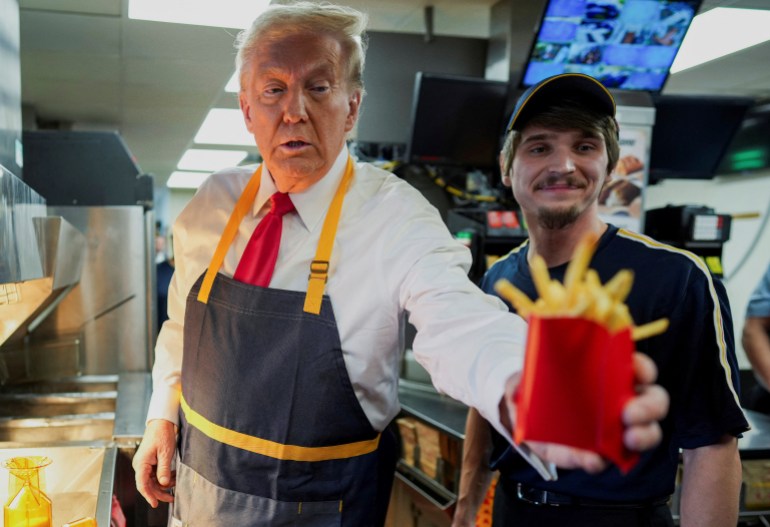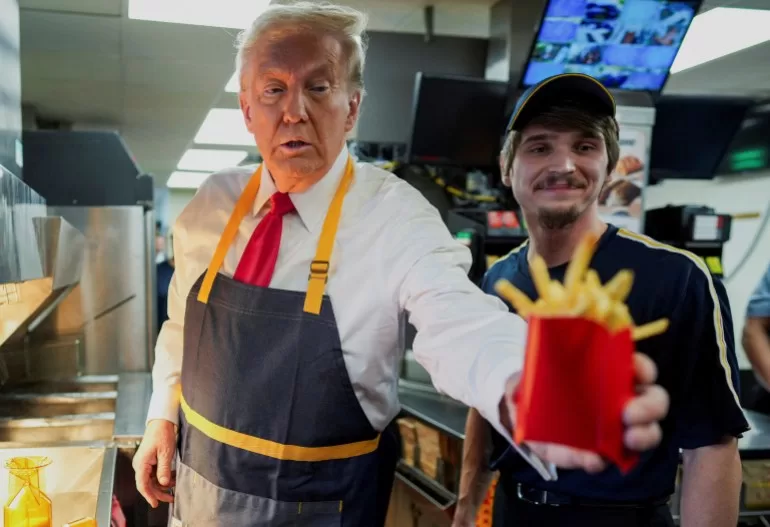Early voting is under way across the United States ahead of Tuesday’s presidential election. Republican candidate Donald Trump and Democratic candidate Kamala Harris have both made last-minute efforts to court union voters – a core voting bloc, especially in swing states like Michigan, where groups like the United Auto Workers (UAW) have significant sway among the electorate.
Vice President Harris has garnered endorsements from important unions across the country, including the UAW, AFL-CIO and Service Employees International Union.
Harris also has the support of the International Association of Machinists and Aerospace Workers, the union behind the latest Boeing strike, which is now entering its eighth week. Boeing picketers say that if she hits the picket line with them, it could help her win more votes.
Meanwhile, former President Trump has also solidified union support, limited though it may be. Members of the Teamsters union have shown stronger support for the Republican nominee. Although the International Brotherhood of Teamsters opted not to endorse either candidate, the union’s president, Sean O’Brien, has campaigned with Trump and appeared on conservative-friendly media outlets in support.
Trump also received an endorsement from the International Union of Police Associations. It comes despite Trump’s false claims about the high rate of crime in American cities, his 34 felony convictions and his campaign owing cities across the US hundreds of thousands of dollars, much of it for police overtime pay.
While Harris has wider support among union members – a 7 percent lead on Trump as 50 percent of union members say they believe Harris’s policies would be better for unions than Trump’s – the latter has garnered support among union members by tapping into issues that are top of mind for the broader electorate like immigration.
“Union members who are likely or could support Donald Trump are really not focused on collective bargaining or economic power but issues that have to do with immigration, issues that have to do with a sense of danger because of levels of crime,” Bob Bruno, professor of labour and employment at the University of Illinois Urbana-Champaign, told Al Jazeera.
Despite Trump’s success in stoking fear about “migrant crime”, violent crime in the US has steadily declined during the administration of President Joe Biden. The most recent FBI data shows a 10.3 percent decline in reported violent crime compared with last year.
Al Jazeera analysed where the candidates stand on key issues important to union workers like collective bargaining and wages. Here’s what we found:
On organising
Harris has a pretty consistent record of being pro-union and was an original co-sponsor of a key workers rights bill – Protecting the Right to Organize (PRO) Act.
The PRO Act, which originally was proposed in 2019, would prevent employers from interfering with union elections, allow for the National Labor Relations Board to hand out financial penalties to companies that violate labour laws and expedite reinstatement of work if workers lose their jobs as a result of a strike.
The bill was reintroduced in 2023 but has not passed the US Congress. Harris said she would sign it into law if elected.
“The Harris campaign is by far the more supportive of organised labour and collective bargaining, and the Trump campaign is outwardly hostile to the idea,” Bruno said.
JD Vance, Trump’s running mate, voted against the PRO Act and has been a vocal critic of the legislation. Vance also rejected several Biden administration nominees to the National Labor Relations Board. In 2020, then-President Trump threatened to veto the PRO Act if it made it to his desk.
The Trump White House also made it harder for workers to organise, including in 2019 when it got rid of a protection implemented during Barack Obama’s presidency that allowed workers to use company email to organise.
“When it comes to Trump, his presidency was an absolute disaster for working people and for union members. His entire term was doing the bidding of corporate CEOs and big corporations from the massive tax giveaways that he bestowed upon them to making it more difficult for workers to organise as a union,” Steven Smith, deputy director of public affairs for the AFL-CIO, told Al Jazeera.
In her capacity as vice president in the Biden administration, Harris spearheaded the White House Task Force on Worker Organizing and Empowerment, which aimed to help better communicate workers rights throughout federal agencies.
On the other hand, Trump has been openly hostile towards workers who are pushing for better working conditions.
In a recent interview with billionaire supporter Elon Musk on X, the social media platform Musk owns, Trump floated the idea of firing workers who are on strike, which would violate federal labour law.
The claim led the UAW to launch a formal complaint with the National Labor Relations Board to investigate Trump and Musk for interfering with workers rights.
On wages
Harris has said that if elected, she would try to raise the federal minimum wage to $15 per hour – an important issue for workers in the service industry and their respective unions because the minimum wage has been stuck at $7.25 an hour since 2009. Since then, its purchasing power has declined by almost 30 percent.

When he was asked about whether he would raise the minimum wage at a campaign event at a Pennsylvania McDonald’s franchise, Trump dodged the question.
In 2020, he said he would prefer minimum wages to be decided by the states.
“I think it should be a state option. Alabama is different than New York. New York is different from Vermont. Every state is different. It should be a state option,” Trump said at the time.
Thirty-four of the 50 US states have raised their minimum wages above the federal minimum.
That means the remaining 16 still have a minimum wage of $7.25 an hour. So for people who work full time at 40 hours per week at those wages, their annual pay would be only $20 higher than the poverty line for a single person household.
When Biden first took office, he pledged to raise the federal minimum wage for all workers. But his efforts to get Congress to pass the legislation were blocked by Republicans and a handful of Democrats. However, Biden did what the administration could do unilaterally and raised the federal minimum wage for federal workers.
Both Trump and Harris have pledged to end income taxes on tips if elected.
Harris has long fought to improve wages across the economy. During her time as attorney general in California, she launched a task force that was intended to crack down on wage theft in the state.
However, it’s not clear how well those efforts performed. By 2022, it was reported that even when workers won wage theft cases against their employers, only one out of seven were paid out those lost wages within five years.
Trump, however, has repeatedly argued against raising wages.
In 2015, he said wages were “too high”. During that time, he also said auto manufacturers should move operations to the southern part of the US to “lower-wage states”.
Despite these policy positions, Trump won the union-heavy state of Michigan in 2016. Biden won the state by 2.8 percentage points over Trump in 2020, and now it’s a dead heat between Harris and Trump in the state. An aggregate of political polls compiled by the poll-tracking website FiveThirtyEight shows Harris has a small lead in Michigan but well within the margin of error.
In 2018 while president, Trump used an executive order to scrap annual pay raises for civilian federal employees.
The Biden administration, however, has fought to improve wages for middle class workers. In several job creation programmes, the administration included a prevailing wage clause that requires companies bidding for contracts to pay a living wage to their employees.
“The middle class is going to earn prevailing wage on all of those construction and factory-related jobs that come with that large federal subsidy,” Bruno said.
On overtime pay
At the end of Obama’s second term, the Department of Labor said any full-time workers making less than $47,476 qualified for automatic overtime pay.
A judge in Texas blocked the rule before it could take effect. When the plan threshold came up for re-evaluation in 2019, the Trump administration slashed it. The cuts meant employers only needed to pay overtime for salaried workers making $35,358 a year or less.
When the rule was up for reconsideration again this year, the Biden-Harris administration raised the threshold to $43,888 on July 1. It will increase again on January 1 to $58,656. The plan will likely continue if Harris is elected next week.
As for Trump, his allies at the Heritage Foundation think tank want him, if he wins, to reverse the rule.
Trump has a long history of failing to pay overtime during his time in the private sector. A 2016 report from USA Today found that his companies violated overtime and minimum wage laws 24 times.
He echoed that sentiment in a campaign speech this month. The Republican nominee told supporters in Michigan he “used to hate to pay overtime”.
“People are shocked and they’re scared because if Trump takes away their overtime, they’re not going to be able to make their rent at the end of the month. That’s the kind of thing that’s at stake here,” Smith said.
Trump, however, has said he wants to end taxes on overtime pay as part of a bigger tax plan if he is re-elected.
“It’s time for the working man and woman to finally catch a break, and that’s what we are doing because this is a good one,” Trump said at a campaign rally in Arizona in September.
Neither campaign replied to Al Jazeera’s requests for comment.
